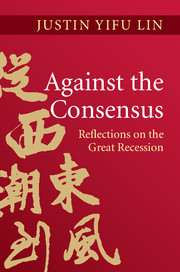Book contents
- Frontmatter
- Contents
- List of figures
- List of tables
- List of boxes
- Preface
- Overview
- Part I What Caused the 2008–9 Global Crisis?
- Part II A Win-Win Path to Recovery
- Part III How Poor Countries Can Catch Up: Flying Geese and Leading Dragons
- 8 The mystery of the great divergence
- 9 The mechanics and benefits of structural change
- 10 Lessons from the failures and successes of structural transformation
- 11 Unique opportunities for poor countries
- Part IV Toward a Brave New World Monetary System
- References
- Index
8 - The mystery of the great divergence
from Part III - How Poor Countries Can Catch Up: Flying Geese and Leading Dragons
Published online by Cambridge University Press: 05 June 2013
- Frontmatter
- Contents
- List of figures
- List of tables
- List of boxes
- Preface
- Overview
- Part I What Caused the 2008–9 Global Crisis?
- Part II A Win-Win Path to Recovery
- Part III How Poor Countries Can Catch Up: Flying Geese and Leading Dragons
- 8 The mystery of the great divergence
- 9 The mechanics and benefits of structural change
- 10 Lessons from the failures and successes of structural transformation
- 11 Unique opportunities for poor countries
- Part IV Toward a Brave New World Monetary System
- References
- Index
Summary
Before the eighteenth century all countries were poor, stagnant, and agrarian. The Industrial Revolution in Britain marked the start of a new era. In the first eight decades of the eighteenth century economic growth in Britain, the world’s leading country, accelerated to an average of 0.7 to 0.8 percent a year. In the nineteenth century growth quickened even more, averaging 2.8 percent a year from 1781 to 1913. More remarkably, output per employee doubled from 1840 to 1911. Several other advanced economies – notably the western European countries, the United States, and other Western offshoots – followed in Britain’s footsteps, and their growth also accelerated. During the past century a few economies in Asia – notably Japan and the East Asian “tigers,” including Hong Kong SAR, China; South Korea; Singapore; and Taiwan, China – also achieved sustained growth that propelled them into the ranks of high-income economies. Most countries, however, failed to advance in the same way. Why?
The great divergence
Between 1950 and 2008 only twenty-eight economies reduced their per capita income gap with the United States by 10 percentage points or more (Table 8.1). Only twelve of the economies were not western European or not oil or diamond producers. The remaining 180 or so countries have remained trapped in their middle- or low-income status. As a result, incomes have diverged widely across countries (Figure 8.1). From an insignificant difference at the beginning of the eighteenth century, per capita income in the developed countries of western Europe and its offshoots rose to more than twenty times that of the developing countries by the end of the twentieth century.
- Type
- Chapter
- Information
- Against the ConsensusReflections on the Great Recession, pp. 101 - 105Publisher: Cambridge University PressPrint publication year: 2013



